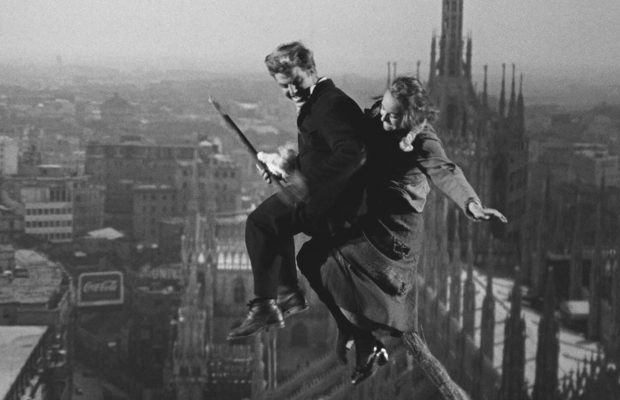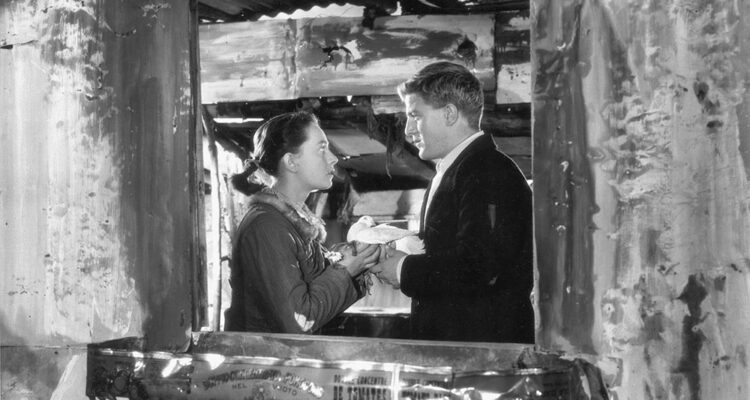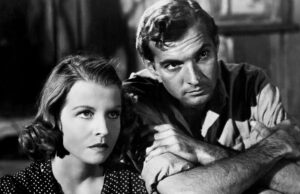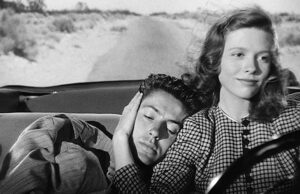Miracle in Milan (1951)

Toronto Film Society presented Miracle in Milan (1954) on Sunday, April 23, 2023 as part of the Season 75 Sunday Afternoon Film Buffs Series, Programme 7.
Directed by: Vittorio de Sica. Produced by: Produziono de Sica, in co-operation with E.N.I.C. (Ente Nazionale Industrie Cinematografiche). Screenplay: Cesare Zavattini and Vittorio de Sica, with Suso Cecchi d’Amico, Mario Chiari, and Adolfo Franci, based on a story by Cesare Zavattini, from his novel “Toto, il buono”. Director of Photography: G.R. Aldo. Sound: Bruno Brunacci. Cameraman: Gianni de Vananzo. Editor: Eraldo de Roma. Special photographic effects: Ned Mann. Musical direction: Alessandro Cicognini.
Cast: Francesco Golisano (Toto), Brunella Bovo (Edwige), Emma Gramatica (Lolotta), Paolo Stoppa (Rappi), Guglielmo Barnabo (The Rich Man), Anna Carena (The Proud Lady), Alba Arnova (The Statue), Flora Cambi (Unhappy Girl in Love) Virgilio Riento (Sergeant), Arturo Bragaglia (Alfredo), Erminio Spalla (Gaetano), Angelo Prioli (Commandant), Francesco Rissone (Second Commandant).
What I Wanted to Say in Miracle in Milan by Vittorio de Sica (from the Miracle in Milan screenplay, published 1968 by The Orion Press).
In spite of the fact that in reality things are quite different, often in fiction we read about the power and heartlessness of the rich and the humble resignation of the poor. The struggle is unequal; but the poor man, by dint of prodigious courage and presence of mind, emerges victorious in the end, just when it seems as if he is faded to succumb. Very often, love is his guiding force, inciting him to victory. Thus, once again, virtue triumphs and evil is punished.
Miracle in Milan, despite certain realistic overtones capable of very, even antithetical, interpretations on the social level, is simply a fairy story and only intended as such. I must admit that I was enchanted by the idea that I, too, could make my contribution – using the most up-to-date means of expression, the cinema – to the eternal moments of the rich man and the poor man that is handed down from the past, for the instruction of children and as a warning to adults.
It is true that my people have already attained happiness after their own fashion; precisely because they are destitute, these people still feel – as the majority of ordinary men perhaps no longer do – the living warmth of a ray of winter sunshine, the simple poetry of the wind. They greet water with the same pure joy as St. Francis did. And what if the water turns out to be gasoline? They rejoiced in it just as much, simply because it can become a fire, a light to brighten their darkness.
They are poor, then, but they are not outcasts. They are not in conflict with so-called civilized society but draw precariously on its fringes, a situation arrived at by a systematic paring down of all their needs, by return to our primitive state of being that is in large part voluntary; in other words, a life in which, as in no other, miracles find their true place. They believe in them without reservation; they adapt themselves to miracles with the greatest of ease as the logical solution to their problems and to a great extent, to desires that have indeed little or nothing to do with the material necessities of life.
They want things to be better than they are. Here the miracle comes to pass that will bring happiness to people who have scarcely the means to feed themselves, a miracle accomplished in peace and in joy, without malice, without the rancor of vengeance. It is a fable, then, a fable of our times, if you will; but the story it tells is as old as all mankind.
I have been asked how and why I made Miracle in Milan. I cannot give a precise answer, however much I ransacked my memory in search of the state of mind that preceded the birth of this film and that accomplished its laborious realization.
I think, however, all the trimmings aside, what decided and won me over to the idea imagined by Zavattini was, as always, the humanity of the central figure who, beneath his present disguises, is again closely related to the characters of the worker and child in Bicycle Thief and the boys in Shoeshine.
For the rest, it is possible that way back at the time of my earliest experiments as an actor-director in Teresa Venerdi, for example, I was already moving in this direction. It is, I believe, simply a way of looking at life: the way in which each of us takes up his position and reacts to the facts of his existence and to the circumstances of other men.

On the one hand, above all, I select the happier, more optimistic aspects of life – its positive side I might say – and neglect the other aspects, perhaps not seeing or understanding them on the other hand, I draw from these “other” aspects the material, the inspiration and the poetry of an ideal world, finding in them the motive of some subtle vexation of my own that leads me to an involuntary and instinctive search for their cause and effect. An artist, a man of letters, a playwright, or even a movie director, will find himself quite naturally attempted to express their meaning and significance in an artistic form.
This explains why I rebel when anyone tries to discover some preconceived message or propaganda in my films, instead of that Christian, or simply human, sense of fellowship which I consider should be common to us all, regardless of the political conventions had held singly or collectively by each one of us.
Once again, then, I have remained faithful to the world of my imagination. But, from a stylistic point of view, Miracle in Milan opened up new paths for me. Its content is humanist, but its inspiration, the climate in which the characters evolve, their way of thinking and behaving, and their very fate itself, is more closely related to the legends of the North, to Andersen for example, than to the reality of our present day Latin world. Here is no hymn in praise of poverty – as I read somewhere to my horror – nor any condemnation of riches. (I do not think either Zavattini or I can be accused of such bad taste in making use of an antithesis that would leave little room in the work for any art!).
This is a fable, slightly wistful perhaps, but quietly optimistic within its poetic framework; if I may be allowed to give it such a name. Men and angels are to be found here, living on good terms together. Toto works miracles for all comers and works them, obviously, for the benefit of those who need them – that is to say, the poor. But these people, with their dreamy, ingenuous looks, do not ask only for things that will satisfy their material needs and alleviate their distress. They ask also for superfluous, even ridiculous things, to appease some secret longing for them. A wardrobe, yes, but a phonograph, too.
In view of the unusual material of which it is composed, the chief problem presented by Miracle in Milan was one of form and style.
It is essentially a fairy story (the oil burns all night, but the following morning it stops) peopled by strange creatures who believe in miracles and who work them themselves; It is a fairy tale for young and old. And yet, the story is always poised midway between reality and fantasy. So I have tried to express it in the style best suited to that kind of story. In this style I have two masters, Clair and Chaplin, towering above me with all the force of their genius; their example drew me on and yet, at the same time, acted as a restraint in a warning to me: it was a dangerous attraction. I had to undertake the difficult enterprise of embarking, on my own account, on a road that was at least equidistant from both of them. It is not my place to say, and I am not qualified to do so in any case, whether this was a new or a well chosen departure.
Finally – to give life to this film of mine, I tried to find the meaning of a little word that likes to hide everywhere: it is goodness. I beg you to tell me if you find it in these images, if you recognize it at least here and there.
Vittorio de Sica (b. July 7 1901 – d. November 13, 1974).










Leave a Reply